Belling BDW60IC User manual

BDW60IC
14 place settings
half-load function

With each wash cycle.
Compartment
For programmes with pre-wash only.
(Follow the user instructions!)
Electric indicator on control panel (if provided).
Check the rinse aid level
Loa d the baskets
Switch off the appliance
Turn o ff the wate r tap,
unload the baskets
Fill the detergent dispenser
Warning : wait a few minutes (about 15 minutes) before unloading the dishwasher to avoid handling
the dishes and utensils while they are still hot and more susceptible to break.
They will also dry better.Unload the appliance, starting from the lower basket.
Scrape off any large amount of leftover food. Soften remnants of burnt food in pans,
then load the b askets. R efer to the dishwash er loading instructions.
When the working cycle has finished, the buzzer of the
dishwasher will sound 8 times, then stop.
Turn off the appliance using the On/Off Button.
Switch on the appliance
For detailed operating method read the corresponding content on the instruction manual.
Select a programme
Turn on the water tap , c lose the door . The machine will start working after about 10 seconds.
Running the dishwasher
Changing th e programme
Add forgotten dishes in the
dishwasher.
If the appliance is switched
off during a wash cycle.
O pen the do or carefu lly.
H o t steam m a y escap e
w h en the do or is ope n ed!
If the appliance is switched off during a wash cycle, when switched
on again, please re-select the wa shing cycle and operate the dishwasher
according to the original Power-on state ).
Press the Programme Button until the selected programme lights up.
( See the section entitled Operationg instruction )“ ”
1. A running cycle can only be modified if it has been running for a short time. Otherwise the detergent
may have already been released and the water already drained. If this is the case, the detergent
dispenser must be refilled.
2. Open the door and press the Programme Button for more than 3 seconds
to cancel the runing progarmme
3.Select a new programme.
4.Close the door,the machine will restart after about 10 seconds.
Open the door,press the On/Off button to switch on the appliance .
1.Open the door a little to stop the dishwasher.
2.After the spray arms stop working, you can open the door completely.
3.Add the forgotten dishes.
4.Close the door, the dishwasher will start running again after 10 seconds.

To review the sect ion on troubleshooting Tips
will help you to solve some co mmon problems
by yourself .
Dear Customer,
Please carefully read this manual before using the
dishwasher, it will help you to use and maintain the
dishwasher properly.
Pass it on to any subsequent owner of the appliance.
This manual contains sections on safety Instructions,
Operating Instructions, Installation Instructions and
Troubleshooting Tips, etc.
The manufacturer, followin g a policy of constant
development and updating of the product, may
make modifications without giving prior notice.
Keep it as a refer in the later days.
If you can not solve the problems by yourself ,
please ask for the help of professional technicians.
This appliance is intended to be used in household
and similar applications such as:
-staff kitchen areas in shops, offices and other
working environments;
-farm houses;
-by clients in hotels, motels and other residential
type environments;
-bed and breakfast type environments.
Dish washer Feat ures....... ... ......... ... ............ ... .. ..2
Attention before or after loading the Dishwashe r
Baskets............... ..................... ........................6
Filtering System.......... ... ... ......... ... ... ................10
Caring for the Dishwasher..................... ...........11.
A Fill the R inse Aid D ispenser. ............ .. . ... 3、..... ...
B Function of Detergent ...........................4、........
................7
The Me thod Loading Normal Dishware
Wash Cycle Table...............................................8
Turni ng on the Applian ce..................... ...............8
Ch ange t he Programme... .. ......... ..... ...... ....... .. 9....
At the Ene of the Wash Cycle...............................9
Before call ing for ser vice........................... .......19.
Err or codes. ... ... ...... .. . ............ . .. ... .. ...... ..........20.
Technical informat ion.............................. .......21..
Control Pan el. ... ...... ... ............ ... ... ... ...... ... ... ... ....2
...... ... ............ ............... 12Installat ion p repara tion
.....13Aesthetic panel's dimensions and installation
................15Tension adjustment of the door spring
..... ... ... ...... ............... 1 5Connection of dr ain ho ses
........................... 16Dishwasher installation steps
About Electricity Connecting.............................17
Cold Water Connection.................................... 18
Sta rt of dishwash er.......... ... ... ............ .... ...... ..18..

This appliance must be grounded. In the event of a
malfunction or breakdown, grounding will reduce
the risk of anelectric shock by providing a path of
least resistance of electric current. This appliance
is equipped with a cord having an equipment-
grounding conductor and a grounding plug.
The plug must be plugged into an appropriate outlet
that is installed and grounded in accordance with
all local codes and ordinances.
Keep children away from detergent and rinse aid, keep
child away from the open door of the dishwasher,
there could still be some detergent left inside.
ren
Do not abuse, sit on, or stand on the door or dish
rack of the dishwasher.
Do not touch the heating element during or
immediately after use.
(This instruction is only applicable to machines
with a visual heating element.)
Do not wash plastic items unless they are marked
dishwasher safe or the equivalent. For plastic items
not so marked, check the manufacturer's
recommendations.
Use only detergent and rinse additives
designed for an automatic dishwasher.
Never use soap, laundry detergent, or hand
washing detergent in your dishwasher. Keep
these products out of the reach of ch ildren.
During installation, the power supply must not
be excessively or dangerously bent or flattened.
Do not tamper with controls.
Do not place any heavy objects the
door when it is open. The appliance could tip
forward.
on or stand on
When loading items to be washed:
1) Locate sharp items so that they are not likely
to damage the door seal;
2 Warning: Knives and other utensils with
sharp points must be loaded in the baske t
with their points down or placed in a
horizontal position.
)
When using your dishwash er, you should
prevent plastic items from comin g into contact
with the heating element.(This instruction is only
applicable to machines with a visual heating
element.)
If the s upply cord is damaged, it must be replaced
by the manufacturer or its service agent or a
similarly qualified person in order to avoid a
haza rd .
Please dispose of packing materials properly.
Use the dishwasher only for its intended function.
Remove the door to the washing compartment when
removing an old dishwasher from service or discarding it.
Dishwasher detergents are strongly alkaline, they
can be extremely dangerous if swallowed. Avoid
contact with skin and eyes and keep children away
from the dishwasher when the door is open.
Check that the detergent comparment is empty
after completion of the wash cycle.
The appliance is to be co nnected to the water
mains using new hose sets and that old hose-sets
should not be reused.
The maximum number of place settings to be
washed is 14.
The maximum permissible inlet water pressure is
1Mpa.
The minimum permissible inlet water pressure is
0.04Mpa.
Children should be supervised to ensure that they do
not play with the appliance.
This appliance is not intended for use by persons
(including children with reduced physical, sensory or
mental capabilities, or lack of experience and
knowledge ,unless they have been given supervision
or instruction concerning use of the appliance by a
person responsible for their safety.
)
When using your dishwasher, follow the precautions listed below:
The door should not be left open,
since this could increase the risk of trippin g.
Improper connection of the equipment-grounding
conductor can result in the risk of an electric shock.
Check with a qualified electrician or service
representative if you are in doubt whether the
appliance is properly grounded. Do not modify the
plug provided with the appliance; If it does not fit
the outlet. Have a proper outlet installed by a
qualified electrician.
Do not operate your dishwasher unless all
enclosure panels are properly in place. Open
the door very carefully if the dishwasher is
operating, there is a risk of water squirting out.

before using it for the first time.
To get the best performance from your dishwashe r, read all operatin g instructions
1.On/Off Button: To turn on/off the power supply.
2.Delay Button : To Press the button to delay.
5. Rinse ai d w ar nin g ligh ts: To show
wh en the dispenser need to b e refilled
7 .P ro gra m ind ica tors: to show wh ich p rog ra m
you have chosen;
4.Delay indicators: to show the delay time
(3h/6h/9h/12h )
3.Power indicator: To show when the power on.
9. Program Button : To Press the button to select a
wash Program.
6.H aft load ind ica to r : To s ho w wh en yo u s ele ct the
haft load function .
8.Half load function Button: To select Half load
function. (With this Half load function you can
only use it when
and you
will see less water and energy consumption , can
only be used with Intensive, Heavy, Normal, Glass
and 1 hour .)
you have only about or less than
half of full load dishes of the dishwasher,
11
12
Back View
1
2
3
4
5
7
89
10
Front view
Lower b asket
Dispenser
Cup shelf
Spray arms
Filter assembly
Inlet pipe connector
Drain pipe
Upper basket
Cutlery rack
Top spray arm
1Inner pipe
5
6
7
8
9
10
12
11
3
2
4
6
Adjus ter

Before using your dishwasher for the first time:
A. Fill the rinse aid dispenser
B. Fill in detergent
The rinse aid is released dur ing the final rinse to prevent water from forming dro plets on your dishes, which can
leave sp ots and streaks . It also improve s drying by allowing water to r oll off the dishes. Your dishwasher is
designed to use liquid rinse aids. The rinse aid dispenser is located inside the door ne xt to the detergent dispenser.
To fill the dispenser, open the cap and pour the rinse aid into t he dispenser until the level indicator tur ns completely
black. The volume of the rinse aid container is about 110ml.
Rinse Aid Dispenser
Function of Rinse Aid
Rinse aid is automat ically added during the l ast rinse, ensuring thorough rinsing, and spot and streak free dr ying.
Attention!
O nly us e br anded rinse ai d for dishwasher. Nev er fill t he rinse aid dispenser with any other substances
(e.g. Dishwasher cleani ng agent, liquid deter gent) . This would damage the applianc e.
As the rinse aid diminishes, the size of the black dot
on the rinse aid level indicator changes, as illustrated below.
Full
3 / 4 full
1 / 2 full
1 / 4 full - Should refill to eliminate spotting
Empty
If the re is no rinse-aid warning light in the control panel, yo u can judge the amount of rinse-aid by the color of the
optical level
indicator "C" located next to the cap. When the rinse-aid container is full, the whole indicator will be dark .A s the
rinse-aid
diminishe s, the size of the dark dot decreases. You should never let the rinse aid get below 1 / 4 full.
When to Refill the Rinse Aid Dispenser
RINSE AID DISPENSER
To open the dispenser, turn the cap to the " open" ( lef t) arrow and lif t it out .
Pour the rinse aid into the dispenser, being careful not to overfill.
Replace the cap by inserting it aligned with "open" arrow and turning it to the closed (r ight) arrow.
Be caref ul not to overfil l the dispenser, because this could cause over sudsing. Wipe away any spills
with a dam p cloth. Don't forget to replace the cap before you close dishwasher door.
Attention!
Clean up any rinse aid split duri n g f illing with an absorbent cl oth to avoid exces s f oaming
du ri ng the next wa sh.
1
2
3

Adjusting Rinse Aid Dispenser
The r ins e aid dispe nser h a s si x or fo ur set tings . Al wa ys st art w it h the disp enser
set on "4" . I f spo ts and po or dr yin g a re a p roblem , increase t he am ount of r ins e
aid dispensed by remov ing t he dispens er l id and rot ating the dial to "5". If the
di she s s ti ll are no t dryin g p rope rl y or ar e show spots, a dju st t he dia l to the n ex t
higher lever until your dis hes are s pot -free. The recomme nded sett ing is "4".
(Factory va lue is "4".)
Increase the dose if t here are dro ps of water or lime spot s on the dishes after washin g.
Red uce it if there are s ti cky w hi tish s tai ns on you r dish es or a b luish f ilm o n g las swar e o r
kn if e bla des.
during the next wash. Don't forget to replace the cap before you close dishwasher door.
Clean up any rinse aid spilled while during filling with an absorbent cloth to avoid excessive foaming
Det ergents with it s chem ical ingr edients are ne cessary to remove dirt, crush dir t and transport it out of the dish wa sher.
Most of the commercial qual ity det ergents are suit able for this purpose.
Detergents
There are 3 sorts of detergents
1.With phosphate and with chlorine
2.W ith phos phate an d without chlorin e
3.Without phosphate and without chlorine
Based on their chemical composition, detergents can be split in two basic types:
Detergent tablets of different brands dissolve at different speeds. For this reason some
detergent tablets cannot dissolve and develop their full cleaning power during short
programs. Therefore please use long programs when using detergent tablets, to
ensure the complete removal of detergent residuals.
The dispenser must be refilled before the start of each wash cycle following the instructions
provided in the wash cycle table . Your dishwasher uses less detergent and rinse aid than
Conventional dishwasher. Generally, only one tablespoon of detergent is needed for
a normal wash load. More heavily so iled items need more detergent. Always add the
detergent just before starting the dishwasher, otherwise it could get damp and will not
dissolve properly.
Concentrated Detergent
Detergent Tablets
Detergent Dispenser
conventional, alkaline detergents with caustic components
low alkaline concentrated detergents with natural enzymes
Normally new pulverised detergent is without phosphate. Thus the water softener functio n of
phosphate is not given. In this case we recommend to fill salt in the salt container even when
the hardness of water is only 6 dH. If detergents without phosphate are used in the case of hard water
often white spots appear on dishes and glasses. In this case please add more detergent to reach
better results. Detergents without chlorine do only bleach a little. Strong and coloured spots will not
be removed completely. In this case ple ase choose a program with a higher temperature.
°

Amount of Detergent to Use
Proper Use of Detergent
Use only detergent specifically made for the use in dishwashers. Keep your detergent fresh and dry.
Don't put powdered detergent into the dispenser until you're ready to wash dish es.
Dishwasher detergent is corrosive! Take care to keep it out of reach of children.
Always add the detergent just before starting each wash cycle.
Only use branded detergent aid for dishwasher.
If the lid is closed: press release button. The lid will spring open.
D eter gent tablet
D eter gent powder
Fill the detergent dispenser with detergent.
The marking indicates the dosing levels , as
illustrated on the right:
The place of main wash cycle detergent placed.
The place of pre-wash cycle detergent placed.
Please observe the manufacturers dosing and storage
Recommendations as st ated on the detergent packaging.
Close the lid and press until it locks in place.
If the dishes are heavily soiled, place an additional
detergent dose in the pre-wash detergent chamber. This detergent will take effect during the pre-wash phase.
A
B
Fill in Detergent
You find information about the amount of detergent for the single programme on page 8.
Please aware, that according to the level soiling and the specif ic hardness of water differences are possible.
Please observe the manufacturer's reco mmendations on the detergent packaging.

Cutlery with wooden, horn china or
mother-of-pearl handles
Plastic items that are not heat resistant
Older cutlery with glued parts that are not
temperature resistant
Bonded cutlery items or dishes
Pewter or cooper items
Crystal glass
Steel items subject to rusting
Wooden platters
Items made from synthetic fibres
Some types of glasses can become
dull after a large number of washes
Silver and aluminum parts have a
tendency to discolour during washing
Glazed patterns may fade if machine
washed frequently
Are not suitable Are of limited suitability
Dishes and items of cutlery must not lie inside one another, or cover each other.
To avoid damage to glasses, they must not touch.
Load la rge items which are most difficult to clean into the lower basket.
The upper basket is designed to hold more delicate and lighter dishware such as glasses, coffee
and tea cups
Long bladed knives stored in an upright position are a potential hazard!
Long and/or sharp items of cutlery such as carving knives must be positioned
horizontally in the upper basket.
Please do not overload your dishwasher. This is important for good results and for
reasonable consumption of energy.
Load hollow items such as cups, glasses, pans etc. With the opening facing downwards so that
water cannot co llect in the container or a deep base.
Consider buying utensils which are identified as dishwasher-proof.
Use a mild detergent that is described as 'kind to dishes'. If necessary, seek further
information from the detergent manufacturers.
For particular items, select a program with as low a temperature as possible.
To prevent damage, do not take glass and cutlery out of the dishwasher immediately
after the programme has ended.
(For best performance of the dishwasher, follow these loading guidelines.
Features and appearance of baskets and cutlery baskets may va ry from your model.)
Scrape off any large amounts of leftover food. Soften remnants of burnt food in pans.
It is not necessary to rinse the dishes under running water.
Place objects in the dishwasher in following way:
1.Items such as cups, glasses, pots/pans, etc. are faced downwards.
2.Curved items, or ones with recesses, should be loaded aslant so that water can run off.
3.All utensils are stacked securely and can not tip over.
4.All utensils are placed in the way that the spray arms can rotate freely during washing.
Very small items should not be washed in the dishwasher as they could easily fall out of the basket.
To prevent water dripping from the upper basket into the lower basket, we recommend that you
empty the lower basket first and then the upper basket.

The upper basket is designed to hold more delicate
and lighter dishware such as glasses, coffee and
tea cups and saucers, as well as plates, sm all bowls
and shallow pans (as long as they are not too dirty).
Position the dishes and cookware so that they will
not get moved by the spray of water.
We suggest that you place large items and the most difficult
to clean items into the lower basket: such as pots, pans, lids,
serving dishes and bowls, as shown in the figure below.
It is preferable to place serving dishes and lids on the side of
the racks in order to avoid blocking the rotation of the top
spray arm.
Pots, serving bowls, etc, must always be pla ced top down.
Deep pots should be slanted to allow water to flow out.
Please be reminded that:
The Bottom Basket features folding spikes so that larger or more pots and pans can be loaded.
Folding Sp ikes of Lo wer Basket
For better stacking of pots and pans,
the spikes can be folded down as
shown in the picture right.
Folding back the cup shelves
For better stacking of pots and pans,
the spikes can be folded down as
shown in the picture right.
Adjusting the Upper Basket
The height of the upper basket can be adjusted in order to
create more space for large utensils both for the upper
/lower basket. The height of the upper basket can be
adjusted by placing the wheels on different height of the
rails. Long items, serving cutlery, salad servers and knives
should be placed on the shelf so that they do not obstruct
the rotation of the spray arms..
Cutlery should be placed in the cutlery rack separately
from each other in the appropriate positions, and do
make sure the utensils do not nest together, this may
cause bad performance.

Means: need to fill rinse into the Rinse-Aid Dispense r.
( )
* : This program is the test cycle. The information for comparability test
in accordance with , as follows:
AS/NZS 2007.1
AS/NZS 2007.1
Capacity: 14 setting
Positio n Upper basket: upper wheels on rails
Rinse aid setting: 6
Open the door slightly 50mm to assist in drying of the dishes after every wash
Starting a cycle wash
Draw out the lower and upper basket, load the dishes and push them back.
It is commended to load the lower basket first, then the upper one (see the section entitled
Loading the Dishwasher ).
Pour in the detergent (see the section entitled Detergent and Rinse Aid ).
Insert the plug into the socket. The power supply is 220-240 VAC /50 HZ, the specification
of the socket is 10A 250VAC. Make sure that the water supply is turned on to full pressure.
“ ”
“ ”
Open the door, press the ON/OFF Button, and the Power indicator light will turn on.
Press the program Button , the wash program will be changed as follows direction:
If a program is selected, the response lig ht will light. Then close the door, the dishwasher
begin s to start.
Intensive->Heavy->No raml->Glass->1Hour->Rap id;
1
2
3
4
5
Glass
For lightly soiled loads,
such as glasses,
crystal and fine china.
20g
Pr e- was h
was h( 40 )
Rinse
Rinse(60 )
Dr yi ng
℃
℃
115
0. 8 14 .5
Normal
Int ensive
Heavy
(Or All )in 1
5 /27 .5g
5
(Or All )
/2 7.5 g
in1
( Or All )in1
5/27.5g
F or n or mall y so iled lo ad s,
s uch as , pl at es,g la sses
a nd l ightl y soile d pans.
s ta nda rd dai ly cycl e.
p ot s
F or the h ea vi est soile d
loa ds, su ch a s po ts , p ans ,
c asserole dis hes and dishe s
that have b ee n sitting w ith
d ried food on them for a
while.
A shorter was h for lightly
soile d loads that do not
n eed dryi ng.
Rapid
Pre-wash(50 )
Wash (65 )
Rins e
Rins e
Rins e(65 )
Drying
℃
℃
℃
Pre-wash(45 )
Wash ( 55 )
Rins e
Rins e (60 )
Drying
℃
℃
℃
Pr e- wa sh
Was h (50 )
Rins e
Rins e( 50 )
Dr yi ng
℃
℃
Wa sh ( 40 )
Rinse
Rinse ( 45 )
℃
℃
165
160
135
40
1.15
0.8 7
1. 4
0.5
18
14 .5
13.6
1 0.5
1 Hour
Pre-wash(50 )
Wash(60 )
Rinse (55 )
Drying
℃
℃
℃
60 10
0.9
5/27.5g
20g
Daily wash in only 1 hour.
For lightly and normally
soiled pla tes and pans
for everyday.
( *AS/ NZS 2 007. 1)
Fo r hea vil y so il ed loads ,
such as po ts, pl ate s, g las ses
an d li ght ly soi led pans .

When the working cycle has finished, the buzzer of the dishwasher will sound for 8 seconds, then stop. Turn off
the appliance using the ON/OFF button, shut off the water supply and open the door of the dishwasher.
Wait for a few minutes before unloading the dishwasher to avoid handling the dishes and utensils while they
are still hot and more susceptible to breakage. They will also dry better.
Switch Off t he Dis hwasher
The program light is on but is not blinking, only in this case the programme has ended.
1.Switch off the dishwasher by pressing the ON/OFF button.
2.Turn off the water tap!
Open the door carefully.
Hot dishes are sensitive to knocks. The dishes should therefore be allowed to cool down around 15 minutes
before removing from the appliance.
Open the dishwasher's door, leave it ajar and wait a few minutes before removing the dishes. In this way they
will be cooler and the drying will be improved.
Unloading the dishwasher
It is normal that the dishwasher is wet inside.
Empty the lower basket first and then the upper one. This will avoid water dripping from the upper Basket onto
the dishes in the lower one.
If you open the door , the machine will pause. The program light will
stop blinking and the buzzer will mooing every minute unless you close the door . After
you close the door ,the machine will k eep on w orking after 10 seconds.
during a wash cycle
Premis e:
A cyc le that is underway can only be modified if it has o nly been running for a short time. Otherwise, the
deter gent may have already been released, and the appliance may have already drained the wash water.
If this is the case, the detergent dispenser must be refille d (see the section entitled " Loading the
Detergent " ).
Open the door ,press the Program button , the mach ine will be in standby state,
then y ou ca n change the program to the desired cycle settin g (see the section entitled " Starting a
wash cycle. . ." ).
more than 3 seconds
1
2
A forgotten dish can be added any time before the detergent cup opens.
Add forgotten dishes.
Close the door
After the spray arms stop working, you can open the door
completely.
2
3
Open the door a little .
1 4
5The dishwasher will run after 10 seconds.
Wash the arms in soapy and warm water and use a soft brush to
clean the jets. Replace them after rinsing them thoroughly.
When following this procedure from step1 to step 3, the filter system will be removed;
when following it from Step 3 to Step 1, the filter system will be installed.
It is dangerous to open the door when washing, because the hot water may scald you.

The filter prevents larger remnants of food or other objects from getting inside the pum.
The residues may block the filter, in this case they must be removed.
The filter system consists of a coarse filter,a flat (Main filter)
And a microfilter(Fine filter).
Food and soil particles trapped in this filter are pulverized by a
special jet on the lower spray arm and washed down to drain.
Larger items, such as pieces of bones or glass, that could block
the drain are trapped in the coarse filter. To remove the items
caught by the filter, gently squeeze the tap on the top of this
filter and lift out.
This filter holds soil and food residues in the sump area and
prevents it from being redeposit on the dishes during wash cycle.
Main filt er
1
Coarse filter
2
Fine filter
3
2
3
1
Filter assembly
The filter efficiently
For best performance and results, the filter must be cleaned regularly. this reason, it is a good idea to
remove the larger food particles trapped in the filter after each wash cycle by rinsing the semicircular filter and
cup under running water. To remove the filter device, pull the cup handle in the upward direction.
removes food particles from the wash water, allowing it to be recycled during the cycle.
For
The dishwasher must never be used without the filter s.
Improper replacement of the filter may reduce the per formance level of the appliance
and damage dishes and utensils.
Step 1 Turn the filter in anti-clockwise direction,:
Step 2 lift the filter assy up:
When following this procedure from step1 to step 2, the filter system will be removed;
when following it from Step 2 to Step 1, the filter system will be installed.
1
2

The control panel can be cleaned by using a lightly dampened cloth.
After cleaning, make sure to dry it thoroughly.
For the exterior, use a good appliance polish wax.
Never use sharp objects, scouring pads or harsh cleaners on any part of the dishwasher.
Protect Against Freezing
1.Cut off the electrical power to the dishwasher.
2.Turn off the water supply and disconnect the water inlet pipe from the water valve.
3.Drain the water from the inlet pipe and water valve. (Use a pan to gather the water)
4.Reconnect the water inlet pipe to the water valve.
5.Remove the filter at the bottom of the tub and use a sponge to soak up water in the sump.
please take frost protection measures on the dishwasher in winter. Every fter washing cycles,
please operate as follows
time a
:
Cleaning t he Filter
Cleaning The Door
To clean the coarse filter and the fine filter, use a cleaning brush. Reassemble the filter parts as shown in the figures
on the last page and reinsert the entire assembly in the dish washer, positioning it in its seat and pressing downwards.
When cleaning the filt ers, don't knock on them. Otherwise, the filters could be
contorted and the performanc e of the d ishwash er could be dec reased.
To clean the edge around the door, you should use only a soft warm, damp cloth.
To avoid penetration of water into the door lock and electrical components, do not
use a spray cleaner of any kind.
Never use a spray cleaner to clean the door panel as it may damage the door lock
and electrical components.
Abrasive agents or some paper towels should not be used because of the risk of
scratching or leaving spots on the stainless steel surface.
Cleaning t he Spray Arms
If yo ur dishwash er ca nn ot wo rk because of the ice,
p lea se co ntac t p rofes sio na l s er vic e p erso ns .
It is necessary to clean the spray arms regularly for hard
water chemicals will clo g the spray arm jets and bearings.
- Inspect the filters for blocking after every time the dishwasher has been used.
- By unscrewing the coarse filter, you can remove the filter system. Remove any food remnants and
clean the filters under running water.
Remarks:
The entire filter assembly should be cle aned once a week.
To remove the lower spray arm, pull out the spray arm upward.
To remove the upper spray arm, hold the nut, rotate the arm
clockwise to remove it.
Wash the arms in soapy and warm water and use a soft brush to
clean the jets. Replace them after rinsing them thoroughly.

It is recommend that you run a wash cycle with the
dishwasher empty and then remove the plug from the
socket, turn off the water supply and leave the door of
the appliance slightly open. This will help the door
seals to last longer and prevent odours from forming
within the appliance.
If the applia nce must be moved, try to keep it in the
vertical position. If absolutely necessary, it can be
positioned on its back.
One of the factors that cause odours to form in the
dishwasher is food that remains trapped in the seals.
Periodic cleaning with a damp sponge will prevent this
from occurring.
Before cleaning or performing maintenance, always
remove the plug from the socket.
To clean the exterior and rubber parts of the dishwasher,
do not use solvents or abrasive cleaning products.
Only use a cloth with warm soapy water.
To remove spots or stains from the surface of the
interior, use a cloth dampened with water an a little
vinegar, or a cle aning product made specifically for
dishwashers.
Re move the Plug
No Solve nts or Abrasive Cleaning
Moving the Appliance
Seal s
After every wash, turn off the water supply to the
appliance and leave the door slightly open so that
moisture and odours are not trapped inside.
Af ter Eve ry Wash
When not in Use for a LongTim e
The installation of the pipes
and electrical equipments
should be done by professionals.
Electrical Shock Hazard
Disconnect electrical power before
installing dishwasher.
Failure to do so can result in death or
electrical shock.
The installation position of dishwasher should be near the existing inlet and drain hoses and
power co rd.
One side of the cabinet sink should be chosen to facilitate the connection of drain hoses of
the dishwasher.
Installation preparation
Note: please check the accompanying in stallation accessories(hook for aesthetic panel,screw)
●

Please car efully read the install ation instruction.
Illustrations of cabinet dimensions and installation position of the dishwasher
Preparations should be made before moving the dishwasher to the installation place .
Choose a place near the sink to facilitate the installation of inlet and drain hoses
(see figure 1).
If dishwasher is installed at the corner of the cabinet, there should be some space
(illustrated in figure 2) when the door is opened.
2
1
Minimum spac e when
the door is opened
【 】Fig ure2
Cabine t dimensions
【 】Figure1
Cabinet
Dishwasher
Door of
dishwasher
Minimum space of 50mm
1The aesthetic wooden panel could be processed according to the Figure 3.
The aesthetic panel should
be processed in accordance
with the illustrated dimensions
【 】Figure3
●Aesthetic panel's dimensions and installation
Less than 5mm
between the top
of dishwasher and
cabinet and the
outer door aligned
to cabinet.
90 °90 °
600 mm
820mm
100
580mm
80
Space between cabinet
bottom and floor
Electrical, drain and
water suppl y line
entrances
(Unit: mm)

I nstalla tion of aesth etic panel
【 】Figure4a
2 Install the hook on the aesthetic wooden panel and put the hook into the slot of the outer door of
dishwasher(see figure 4a). After positioning of the panel , fix the panel onto the outer door by
screws and bolts(See figure 4b) .
Ins tallation of aesthetic
wood en pan el
【 】Figure4b
. take away the four
short screws
. pin up the four long
screws
1
2

Tension adjustment
of the door sprin g
【 】Figure5
Tension adjustment of the door spring
●
Connection of drain hoses
●
The door springs are set at the factory to the proper te nsion for th e oute r door.
If aest hetic woode n panel are instal led, you will have to adjust the door spring tension.
Rotate the adjusti ng screw to drive t he ad justor to strain or relax the steel cable
(see fi gure 5).
Door spring tension is correct w hen
the door remains horizontal in the
fully opened position yet rises
to a close wit h the slight lift of a
finger.
,
Insert the drain hose into a drain pipe with a minimum diameter of 40mm, or let it run into the sink, making sure to
avoid bending or crimping it. The top of the hose must be less than 1000mm.
A
Counter
Front
Drain pipe
NOTE
The top of the hose
must be less th an
1000mm.
φ40 mm
B

【Figure 7】
Dishwasher installation steps
●
1 Install the furniture door to the outer door of the dishwasher using the brackets provided. Refer
to the template for positioning of the brackets.
2 Adjust the tension of the door springs by using an Allen key turning in a clock wise mot ion to
tighten the left and right door springs. Failure to do this could cause damage to your dish washer
(Ill ustration 2).
3 C onnect the inlet hose to the cold water supply .
4 C onnect the drain hose. Refer to diagram.(Figure 6)
5 C onnect the power cord.
6 Affix the condensation strip under the work surface of cabinet. Please ensure the condensation
strip is flush with edge of work surface.
7 Place the dishwasher into position.(Illustration 4)
8 L evel the dishwasher. The rear food ca n be adjusted from the front of the dishwasher by turning
the Allen screw in the middle of the base of dishwasher use an Allen key (Illustration 5A). To adjust
the front feet, use a flat screw driver and turn the front feet un til the dishwasher is level (Illustration 5B).
9 The dishwasher must be secured in place. There are two ways to do this:
A. N ormal work surface:Put the right(left) installation hook i nto the slo t of the ri ght(left) side plane and
secure it to the work surface w ith two woodscrews (Illustration 6).
B. Marble or granite work top:Bend the right(left) installation hook into right-angle,and put it into the
slot of the right(left) side plane and secure it to the work s urface with two woodscrews s (Illustration 7).

Dishwasher mus t be le vel for proper dish rack operati on and wash perfor mance.
Place a spirit level on door and rack track inside the tub as show n to check that the
dishwa sher is level.
level th e dish washe r by adjusting the three levellin g legs individ ually.
When level th e dish washer, plea se pay attention not to let the dishwasher tip over.
1
2
3
Illustration of feet adjustment
【 】Figure 8
NOTE:
The maximum adjustment
height of the feet is 50 mm.
This appliance must be earthed. In the event
of a malfunction or breakdown, earthing will
reduce the risk of electric shock by providing a
path of least resistance for the elect ric current.
This appliance is equipped with a cord having an
equipment-earthing conductor and an earthing
plug. The plug must be plugged into an appropriate
outlet that is installed and earthed in accordance
with all local standards and requirements.
Improper conn ection of the equipmen t-
groundin g condu ctor can result in t he risk
of an elect ric sh ock. Check with a qua li fi ed
electr ici an or service represen tat ive if you
are in doubt whet her the appli ance is properl y
grounded. D o not modi fy the plug provided w ith
the appl iance ; If it is not f it for the outlet.
Have a proper outlet in stal led by a qualif ie d
electr ician.
Ensure the voltage and frequency of the power being corresponds to
those on the rating plate. Only insert the plug into an electrical socket which is earthed
properly. If the electrical socket to w hich the appliance must be connected is not
appropriate for the plug , replace the socket, rather than using a adaptors or the like as
they could cause overheating and b urns.
Please look at the rating label to know the rating voltage and connect the dishwasher to the appropriate power supply.
Use the required fuse 10 amp, time delay fuse or circuit breaker recommended and provide separate circuit serving
only this appliance.
For personal safety:
DO NOT USE AN EXTENSI ON CORD OR AN ADAPTER PLUG WITH THIS APPLIANCE.
DO NOT, UNDER ANY CIRCUMSTANCES, CUT OR REMOVE THE E ARTHING
CONNECTION FROM THE POWER CORD.
Ch eck l e ve l s id e t o side
Spirit level
C heck leve l Front t o B ack
Table of contents
Other Belling Dishwasher manuals

Belling
Belling BDW60WTE User manual
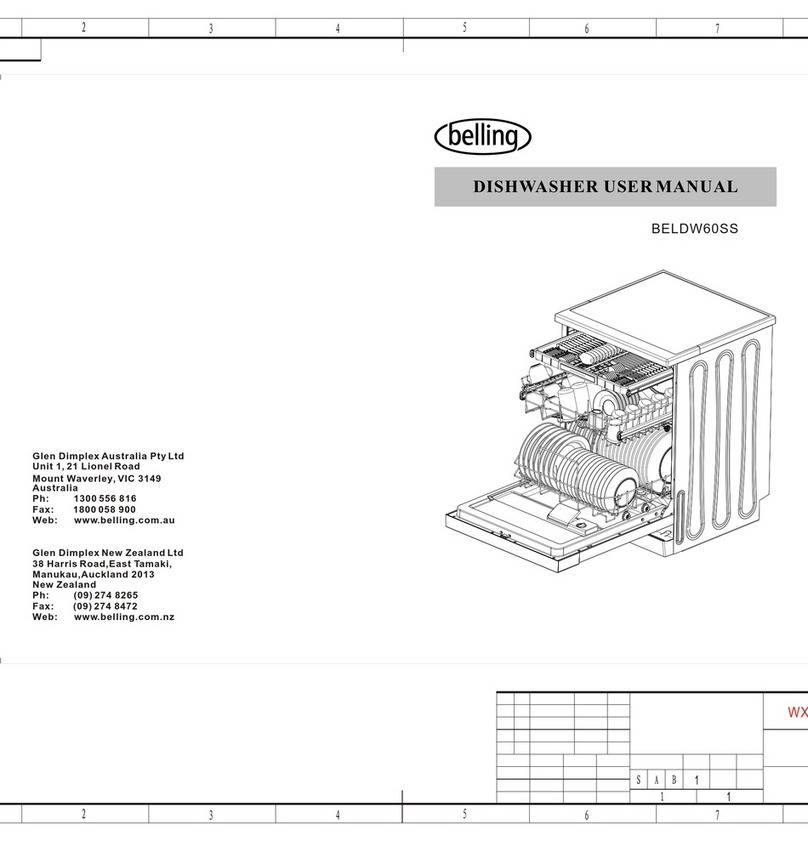
Belling
Belling BELDW60SS User manual

Belling
Belling bdw60ss User manual

Belling
Belling BEL IDW45 User manual
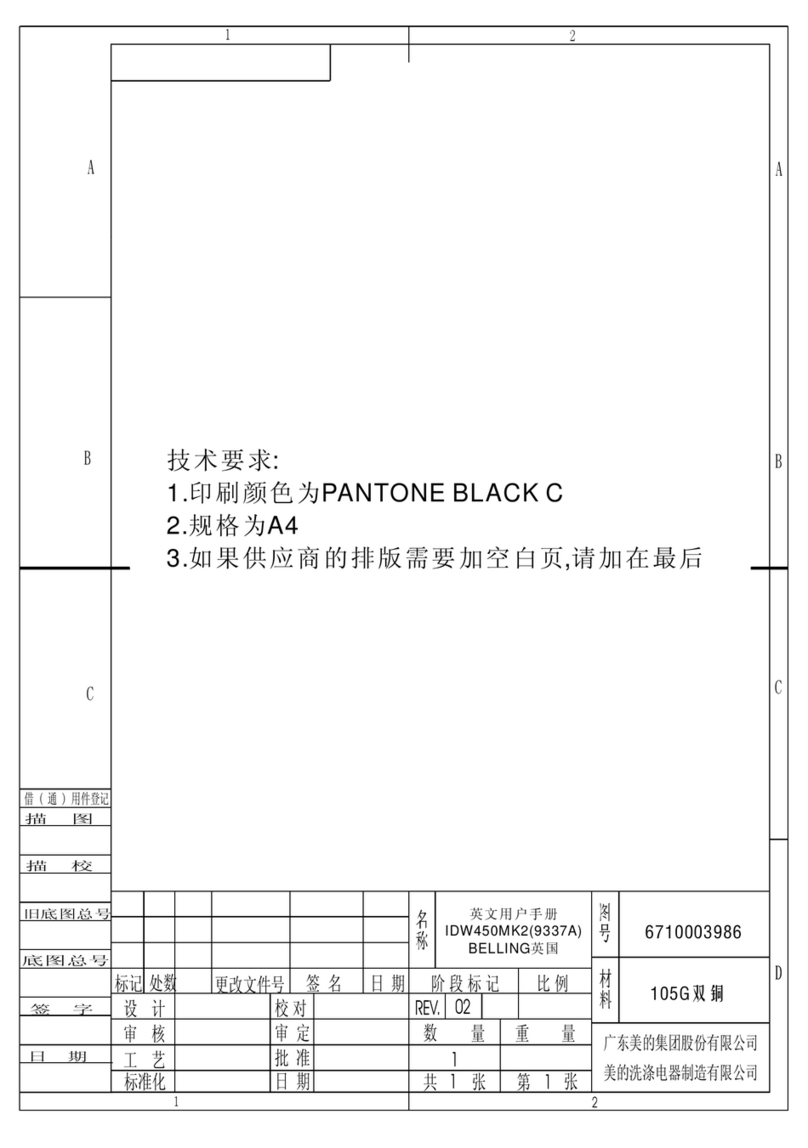
Belling
Belling IDW450MK2 User manual
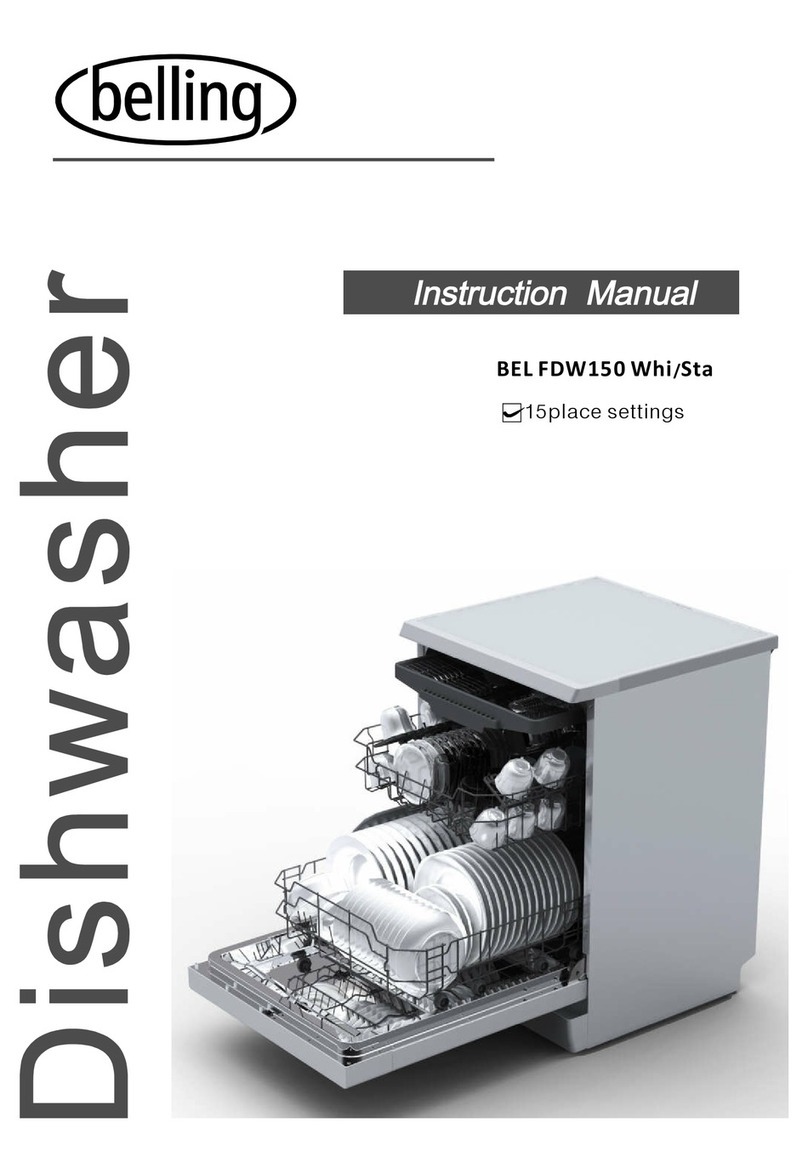
Belling
Belling BEL FDW150 Whi Sta User manual
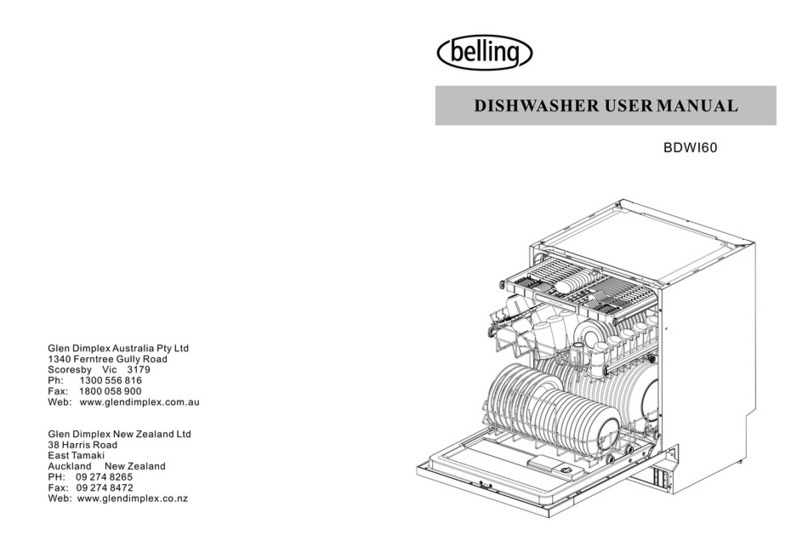
Belling
Belling BDWI60 User manual
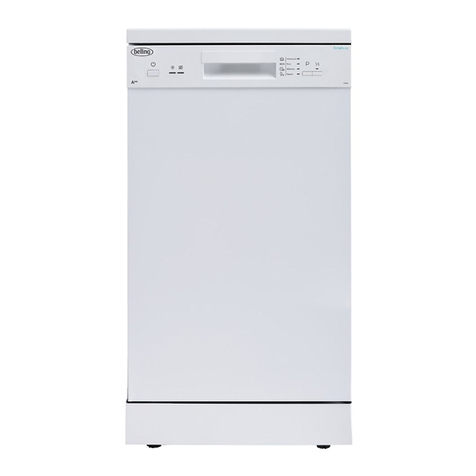
Belling
Belling BEL FDW90 WHI User manual

Belling
Belling IDW604MK2 User manual
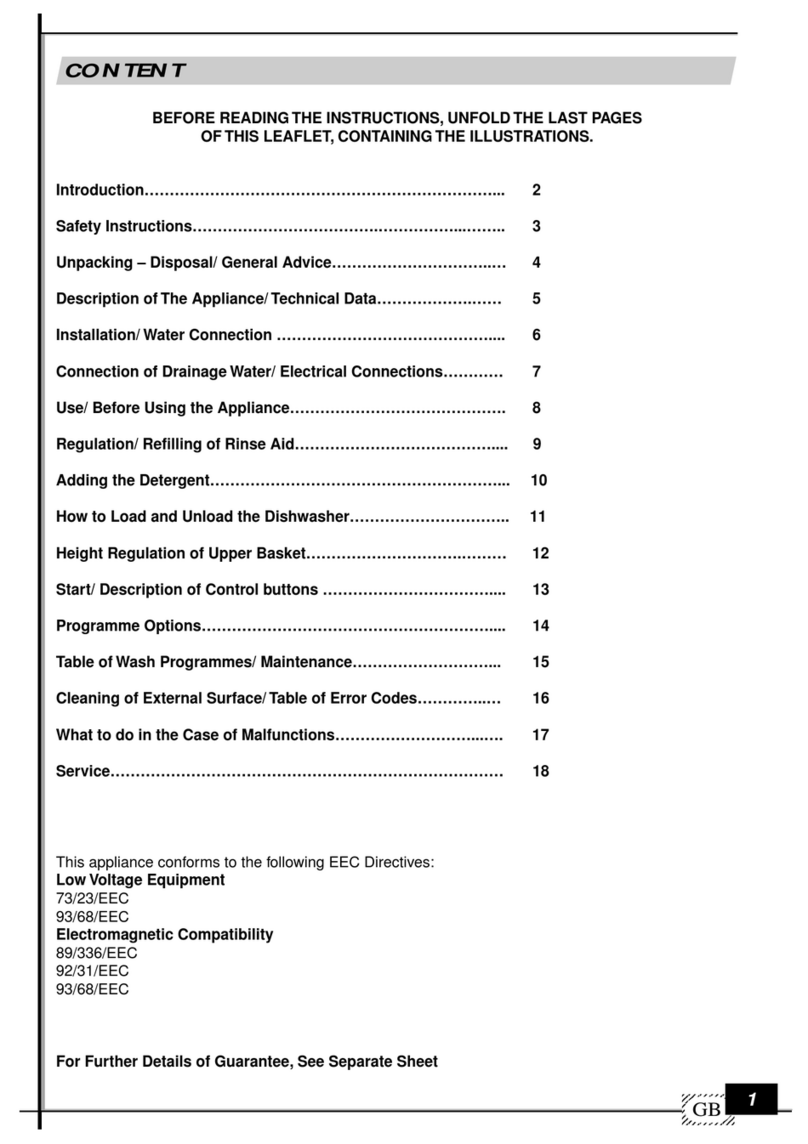
Belling
Belling IDW603 Instruction manual

















